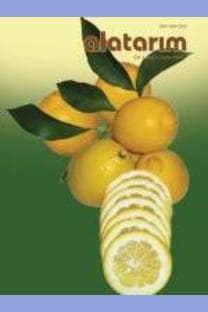The Effects of Fruit Development and Physico-Chemical Changes on the Optimum Harvest Maturity in Some Astringent Persimmon Cultivars
Bazı Buruk Trabzon Hurması Çeşitlerinde Optimum Hasat Olgunluğuna Meyve Gelişiminin ve FizikoKimyasal Değişimlerin Etkileri
___
Akbulut, M., N. Kaplan, I. Macit, A. Koç, 2004. Persimmon (Diospyros kaki L.) selection in the Black-Sea Region. I. Persimmon Growing and Marketing Symposium. Ünye-Ordu, Turkey. 32‒40 (in Turkish with an abstract in English).Akça, Y., Özkan, Y., Kaya, E., Gümüş, A., Keskin, S., 1999. Studies on the selection of Diospyros kaki L. in Tokat Region. Turkey III. National Horticulture Congress. Ankara, Turkey. 792‒794 (in Turkish with an abstract in English).
Çandır, E.E., Özdemir, A.E., Kaplankıran, M., Toplu, C., Demirkeser, T.H., Yıldız, E., 2008. Cold storage of ‘Harbiye’ and ‘Vainiglia’ persimmons grown in Dörtyol condition. IV. National Horticulture Congress. Antalya, Turkey. 284‒291 (in Turkish with an abstract in English).
Çandır-Ertürk E., Özdemir, A.E. Kaplankıran, M., Toplu, C., 2009. Physico-chemical changes during growth of persimmon fruits in the East Mediterranean climate region. Scientia Horticulturae 121: 42–48.
Çandır, E., Özdemir, A.E., Kaplankıran, M., Demirkeser, T.H., Yıldız, E., 2010. Storage life of non-astringent persimmons grown in the Eastern Mediterranean. New Zeal. J. Crop Hort. 38: 1‒6.
Crisosto, C.H., Mitcham, E.J., Kader, A.A., 1995. Persimmon: Recommendations for maintaining postharvest qualityhttp://postharvest.ucdavis.edu/Commodity Resources/Fact_Sheets/Datastores/Fruit_ English/?uid=48&ds=798.
Ertürk, E., Özdemir,A.E., Kaplankıran,M., Toplu, C., 2003. The cold storage of Harbiye persimon. IV. National Horticulture Congress. Antalya, Turkey. 172‒173 (article in Turkish with an abstract in English).
Ertürk, E., Özdemir, A.E., Toplu, C., Kaplankıran, M., Şahin, H., 2004. The cold storage of Jiro persimmon. I. Persimmon Cultivation and Marketing Symposium. Ünye-Ordu, Turkey. 1: 111‒116 (article in Turkish with an abstract in English).
Forbus, Jr. W.R., Payne, J.A., Senter, S.D., 1991. Nondestructive evaluation of Japanese persimmon maturity by delayed light emission. J. Food Sci. 56:985–988.
Harker, F.R., Forbes, S.K., 1997. Ripening and development of chilling injury in persimmon fruit: An Electrical Impedance Study. NZ. J. Crop Hort. Sci. 25: 149‒57.
George, A., Collins, R., Nissen, R., 1994. Growth, yield and fruit quality of two non-astringent persimmon (Diospyros kaki) cultivars, Izu and Fuyu, in Subtropical Australia. Aust. J. Exp. Agric. 34: 267‒275.
Godoy, C., Monterubbianesi, G., Tognetti, J., 2008. Analysis of highbush blueberry (Vaccinium corymbosum L.) fruit growth with exponential mixed models. Sci. Hortic. 115: 368–376.
Kitagawa, H., Glucina, P.G., 1984. Persimmon culture in New Zealand. New Zealand Department of Scientific and Industrial Research, DSIR Information Series, Wellington, New Zealand, 159: 74 p.
Mowat, A.D., George, A.P., 1996. Environmental physiology of persimmons. In: Schaffer, B. and Andersen, P.C. (editors). Handbook of Environmental Physiology of Fruit Crops 1: 195 ‒ 202.
Mowat, A.D., George, A.P., Collins, R.J., 1997. Macro-climatic effects on fruit development and maturity of nonastringent persimmon (Diospyros kaki L. cv. Fuyu). Acta Hortic. 436: 195‒202.
Onur, S., 1995. Adaptation of persimmon varieties. Derim 12 (1): 8‒18 (in Turkish with an abstract in English).
Onur, C., Onur, S., 1997. Selection of persimmon (Diospyros Kaki L) in the Black-Sea Region. Derim 14 (4): 146‒156 (article in Turkish with an abstract in English).
Özdemir, A.E., Toplu, C., Yıldız, E., Yıldız, C., Katırcı, B., Duman, C., 2014. Cold storage of Kaki Tipo persimmons grown in Dörtyol conditions. Proceedings of the VI. Storage and Marketing Symposium on Horticultural Crops, Bursa, Turkey. 207– 213 (in Turkish with an abstract in English).
Senter, S.D., Chapman, Jr.G.W., Forbus, Jr.W.R., Payne, J.A., 1991. Sugar and nonvolatile acid composition of persimmons during maturation. J. Food Sci. 56: 989‒991.
Taira, S., 1996. Astringency in persimmon. In: Linskens, H.F. and Jackson, J.F. (Eds.), Modern Methods of Plant Analysis 18: 97‒110.
Tangu, N.A., Erenoğlu, B., Yalçınkaya, E., 2004. Adaptation of the persimmon to ecological conditions in Marmara Region. I. Persimmon Growing and Marketing Symposium. Ünye-Ordu, Turkey. 41‒45 (in Turkish with an abstract in English).
Toplu, C., Kaplankıran, M., Özdemir, A.E., Yıldız, E., Demirkeser, T.H., Çandır, E., 2011. Changes of the quality parameters of some pollination constant and nonastringent (PCNA) persimmons during fruit development and harvest time. Turkey VI. National Horticulture Congress. Şanlıurfa, Turkey. 1: 909‒916 (in Turkish with an abstract in English).
Toplu, C., Özdemir, A.E., Çandır, E., Yıldız, E., 2020. Quality parameters changes during fruit development of some persimmon cultivars grown in Eastern Mediterranean Region conditions. Alatarım 19 (1): 24‒33 (in Turkish with an abstract in English)
- ISSN: 1304-2653
- Yayın Aralığı: 2
- Başlangıç: 2015
- Yayıncı: Alata Bahçe Kültürleri Araştırma Enstitüsü
Hacılar (Kayseri) Yöresi Kayısılarının (Prunus armeniaca L.) Seleksiyonu
Oğuz SAĞLAM, Ercan YILDIZ, Mehmet YAMAN
Ibrahim DEMIR, Kazım MAVI, Zeynep GÖKDAS, Emrah KÖSE
Kazım MAVI, Zeynep GÖKDAS, Ibrahim DEMIR, Emrah KÖSE
Çorum İli Kullanılabilir Hayvansal Atık Kaynaklı Biyogaz Potansiyelinin Belirlenmesi
